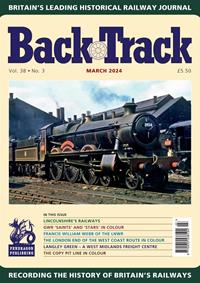|
|
Contents Listing - Articles & Features in this issue
To the Channel and beyond
Colwick: Where Coal was King- Part One
Oxfordshire's Railways
Aspects of a Lancashire Railway Town: 1830-1910
Peak Forest, Buxton and Great Rocks
Horwich's Finest
From Road Unto Rail: Exercises in Technology Transfer - Part Three
In Praise of the Moguls - Part Two
Monton Green - West of Salford
Crossing London: The City Widened Lines and the Thameslink Saga - Part Two
The Southampton Dock Diesels
Trains across the Gill: Hownes Gill Viaduct 1858-1968
Readers' Forum
Book Reviews
Cover - London Midland & Scottish Railway 5MT 2-6-0 No.42939 and its crew take a breakat Rugby on 9th August 1961.
Article Snippets
Four wheels on my wagon:
By the time the end of the nineteenth century eased into the twentieth the quality of railway rolling stock had advanced from the four-wheeled boxes of the pioneering years towards a fairly civilised standard: bogie carriages were becoming prevalent - even some majestic twelvewheelers, as were lavatory facilities, corridor connections, steam heating, dining services... Of course, if you were riding in third class or commuting to work you might have to settle for less but by then you'd be thinking yourself hard done by to find yourself in a six-wheeler.
So it was with some surprise that in the decade of the 1980s we were reintroduced to the concept of the four-wheel railway carriage - or some parts of the country were, anyway. I speak of the 'Pacer' genus of diesel multiple units, in the news over the last six months in being described as 'hated' and as having their imminent demise eagerly anticipated as 'better' trains were transferred to replace them.That happy circumstance was trumpeted for happening in the autumn of 2019 but to no-one's amazement it didn't come to pass.
The impetus for what came to be the 'Pacer' we know and... whatever lies in the wish of British Rail to replace the life-expiring first generation DMUs in a world in which there was no significant money to actually do so. The solution arrived at was basically placing a Leyland bus body on a wagon chassis; explained that way, there was clearly no reason to expect more of them than was consequently delivered.
The type was introduced stealthily with a few prototypes and demonstrators, then a batch of two-car trains constituting what was termed Class 141 to test the air in Yorkshire. They weren't exactly a great passenger experience but nevertheless, with 'lessons learnt' of course, a Class 142 was developed and released into the wild, in certain areas as noted, in 1985. The earlier version wasn't actually known as the 'Pacer' order; the appellation was applied to the Class 142 at a launch ceremony at Manchester Victoria (which came to be quite a haunt of the species) by the local television broadcaster Stuart Hall. Whatever became of him?!
And then twenty years, then thirty and now more, went by as funds for the replacement of these stop-gap four-wheelers failed to materialise. Their municipal bus-type seats were an unwelcome presence in a late twentieth century railway carriage, being intrinsically uncomfortable anyway and disagreeably cramped for leg room for any passenger over about 5ft 9in tall. Their riding was rough to say the least, especially on jointed track, and if seated facing the middle vestibule connection you could see the accompanying vehicle pitching around in a quite different plane to yours - but then they were really only goods wagons. Though I've never had to try it, standing in them (for naturally overcrowding submerged their 78 seats) looked incredibly difficult and involved more standees lurching into and bouncing off each other or landing in laps than is even the case in a packed to suffocation Trans-Pennine Class 185. And as they got older their internal fixtures, notably glass partitions, started vibrating raucously when the unit was in low gear such that their sounds could probably be scored on a musical scale. Needless to say, a trolley service of refreshments couldn't possibly be offered in one!
The 'Pacers' were deployed on 'provincial' services in the North West, Yorkshire, the North East, the West of England and South Wales and it can be conceded that they were adequate, if generally disliked, for short-distance, short-duration runs around populous areas, although they didn't enjoy the tight curves of the West Country branches where their long wheelbase caused flange wear and awful squealing noises. The trouble was that 'Pacers' came to be used on long-distance journeys for which they were not intended and were completely unsuitable: for example, along the North Wales Main Line or on the Trans-Pennine route between Manchester, York and Scarborough, while what might be considered fairly important middle-distance runs such as from Manchester to Sheffield and to Chester often seemed stuck with nothing better. I was once tempestuously conveyed from Skipton to Carlisle by 'Pacer' before the S&C's track had been relaid and was still in a dreadful state, and I was relieved when the journey came to an endI even found the Whitby branch from Middlesbrough something of a trial.
You might have gained an inkling that I've never been a great fan of 'Pacers' but they weren't entirely bad. They were, for example, good for window provision at a time when the first range of'Sprinters' had largely abandoned that notion. OK - that might be all, but I readily accept the argument that at the time they appeared they were better than no trains at all when the only alternative might have been the withdrawal of the old DMUs and the closing of the services they'd worked. It's an indictment of the railways, though, that it has taken so long to replace them.
So much for 'Pacers, then: their day is all but done. Clearance of them has long been forecast and delayed, so few will have reeled thunderstruck at the realisation that they have juddered on into 2020 and a few might be clinging on even yet. Shedding a few historic steam locomotives has left a bit of room for a unit to enter the national collection and doubtless a heritage railway or two will seize the chance to grab one. The question is, then, should Backtrack let them leave the scene unmourned with no further comment, or should the Class 142 be awarded a picture feature, recognising that 35 years' service certainly does place them somewhere in the realms of railway history? I draw the line at a cover picture, however!
By the time the end of the nineteenth century eased into the twentieth the quality of railway rolling stock had advanced from the four-wheeled boxes of the pioneering years towards a fairly civilised standard: bogie carriages were becoming prevalent - even some majestic twelvewheelers, as were lavatory facilities, corridor connections, steam heating, dining services... Of course, if you were riding in third class or commuting to work you might have to settle for less but by then you'd be thinking yourself hard done by to find yourself in a six-wheeler.
So it was with some surprise that in the decade of the 1980s we were reintroduced to the concept of the four-wheel railway carriage - or some parts of the country were, anyway. I speak of the 'Pacer' genus of diesel multiple units, in the news over the last six months in being described as 'hated' and as having their imminent demise eagerly anticipated as 'better' trains were transferred to replace them.That happy circumstance was trumpeted for happening in the autumn of 2019 but to no-one's amazement it didn't come to pass.
The impetus for what came to be the 'Pacer' we know and... whatever lies in the wish of British Rail to replace the life-expiring first generation DMUs in a world in which there was no significant money to actually do so. The solution arrived at was basically placing a Leyland bus body on a wagon chassis; explained that way, there was clearly no reason to expect more of them than was consequently delivered.
The type was introduced stealthily with a few prototypes and demonstrators, then a batch of two-car trains constituting what was termed Class 141 to test the air in Yorkshire. They weren't exactly a great passenger experience but nevertheless, with 'lessons learnt' of course, a Class 142 was developed and released into the wild, in certain areas as noted, in 1985. The earlier version wasn't actually known as the 'Pacer' order; the appellation was applied to the Class 142 at a launch ceremony at Manchester Victoria (which came to be quite a haunt of the species) by the local television broadcaster Stuart Hall. Whatever became of him?!
And then twenty years, then thirty and now more, went by as funds for the replacement of these stop-gap four-wheelers failed to materialise. Their municipal bus-type seats were an unwelcome presence in a late twentieth century railway carriage, being intrinsically uncomfortable anyway and disagreeably cramped for leg room for any passenger over about 5ft 9in tall. Their riding was rough to say the least, especially on jointed track, and if seated facing the middle vestibule connection you could see the accompanying vehicle pitching around in a quite different plane to yours - but then they were really only goods wagons. Though I've never had to try it, standing in them (for naturally overcrowding submerged their 78 seats) looked incredibly difficult and involved more standees lurching into and bouncing off each other or landing in laps than is even the case in a packed to suffocation Trans-Pennine Class 185. And as they got older their internal fixtures, notably glass partitions, started vibrating raucously when the unit was in low gear such that their sounds could probably be scored on a musical scale. Needless to say, a trolley service of refreshments couldn't possibly be offered in one!
The 'Pacers' were deployed on 'provincial' services in the North West, Yorkshire, the North East, the West of England and South Wales and it can be conceded that they were adequate, if generally disliked, for short-distance, short-duration runs around populous areas, although they didn't enjoy the tight curves of the West Country branches where their long wheelbase caused flange wear and awful squealing noises. The trouble was that 'Pacers' came to be used on long-distance journeys for which they were not intended and were completely unsuitable: for example, along the North Wales Main Line or on the Trans-Pennine route between Manchester, York and Scarborough, while what might be considered fairly important middle-distance runs such as from Manchester to Sheffield and to Chester often seemed stuck with nothing better. I was once tempestuously conveyed from Skipton to Carlisle by 'Pacer' before the S&C's track had been relaid and was still in a dreadful state, and I was relieved when the journey came to an endI even found the Whitby branch from Middlesbrough something of a trial.
You might have gained an inkling that I've never been a great fan of 'Pacers' but they weren't entirely bad. They were, for example, good for window provision at a time when the first range of'Sprinters' had largely abandoned that notion. OK - that might be all, but I readily accept the argument that at the time they appeared they were better than no trains at all when the only alternative might have been the withdrawal of the old DMUs and the closing of the services they'd worked. It's an indictment of the railways, though, that it has taken so long to replace them.
So much for 'Pacers, then: their day is all but done. Clearance of them has long been forecast and delayed, so few will have reeled thunderstruck at the realisation that they have juddered on into 2020 and a few might be clinging on even yet. Shedding a few historic steam locomotives has left a bit of room for a unit to enter the national collection and doubtless a heritage railway or two will seize the chance to grab one. The question is, then, should Backtrack let them leave the scene unmourned with no further comment, or should the Class 142 be awarded a picture feature, recognising that 35 years' service certainly does place them somewhere in the realms of railway history? I draw the line at a cover picture, however!
Adverts and Links based on this content
Advertisement




